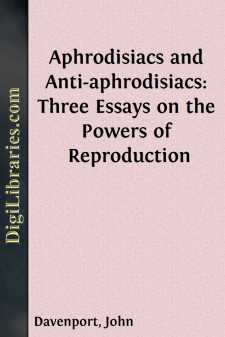Categories
- Antiques & Collectibles 13
- Architecture 36
- Art 48
- Bibles 22
- Biography & Autobiography 813
- Body, Mind & Spirit 142
- Business & Economics 28
- Children's Books 15
- Children's Fiction 12
- Computers 4
- Cooking 94
- Crafts & Hobbies 4
- Drama 346
- Education 46
- Family & Relationships 57
- Fiction 11829
- Games 19
- Gardening 17
- Health & Fitness 34
- History 1377
- House & Home 1
- Humor 147
- Juvenile Fiction 1873
- Juvenile Nonfiction 202
- Language Arts & Disciplines 88
- Law 16
- Literary Collections 686
- Literary Criticism 179
- Mathematics 13
- Medical 41
- Music 40
- Nature 179
- Non-Classifiable 1768
- Performing Arts 7
- Periodicals 1453
- Philosophy 64
- Photography 2
- Poetry 896
- Political Science 203
- Psychology 42
- Reference 154
- Religion 513
- Science 126
- Self-Help 84
- Social Science 81
- Sports & Recreation 34
- Study Aids 3
- Technology & Engineering 59
- Transportation 23
- Travel 463
- True Crime 29
Aphrodisiacs and Anti-aphrodisiacs: Three Essays on the Powers of Reproduction
by: John Davenport
Description:
Excerpt
ESSAY I.
REMARKS UPON THE SYMBOLS OF THE
REPRODUCTIVE POWERS.
ROM the investigations and researches of the learned, there appears to be no doubt but that the most ancient of all superstitions was that in which Nature was contemplated chiefly under the attribute or property of fecundity; the symbols of the reproductive power being those under which its prolific potencies were exhibited. It is not because modern fastidiousness affects to consider those symbols as indecent, and even obscene, that we should therefore suppose them to have been so regarded by the ancients: on the contrary, the view of them awakened no impure ideas in the minds of the latter, being regarded by them as the most sacred objects of worship. The ancients, indeed, did not look upon the pleasures of love with the same eye as the moderns do; the tender union of the sexes excited their veneration, because religion appeared to consecrate it, inasmuch as their mythology presented to them all Olympus as more occupied with amatory delights than with the government of the universe.
The reflecting men of those times, more simple, but, it must be confessed, more profound, than those of our own day, could not see any moral turpitude in actions regarded by them as the design of nature, and as the acme of felicity. For this reason it is that we find not only ancient writers expressing themselves freely upon subjects regarded by us as indecent, but even sculptors and painters equally unrestrained in this particular.
The statesman took advantage of these religious impressions: whatever tended to increase population being held in honour. Those images and Priapi so frequently found in the temples of the ancients, and even in their houses, and which we consider as objects of indecent lewdness, were, in their eyes, but so many sacred motives exciting them to propagate their species.
In order to represent by a physical object the reproductive power of the sun in spring-time, as well as the action of that power on all sentient beings, the ancients adopted that symbol of the male gender which the Greeks, who derive it from the Egyptians, called—Phallus. This worship was so general as to have spread itself over a large portion of the habitable globe, for it flourished for many ages in Egypt and Syria, Persia, Asia Minor, Greece and Italy: it was, and still is, in vigour in India and many parts of Africa, and was even found in America on its discovery by the Spaniards. Thus Garcilaso de la Vega informs us that, in the public squares of Panuco (a Mexican town), bas-reliefs were found which, like those of India, represented, in various ways the sexual union; while at Tlascala, another town of that country, the reproductive act was worshipped under the joint symbol of the generative organs, male and female.
A more surprising fact is, that this worship has, as will be shewn hereafter, been perpetuated to a very late date, among the Christians of Europe.
In its origin, the Phallus or emblem of the generative and procreative powers of nature appears to have been of a very simple and inoffensive character—although it was afterwards made subservient to the grossest and most superstitious purposes....


